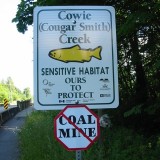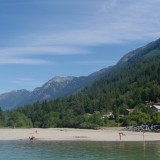“Anywhere else in the world, Howe Sound would be a great National Park”
– Dr. Murray Newman, Former Executive Director – Vancouver Aquarium
A large part of the beauty and international appeal of British Columbia’s West Coast can be found in the natural environment of Howe Sound. Over the past 20 years, Howe Sound has been the subject of millions of dollars in reclamation projects to restore its health, paid for by industry and you the taxpayer. Regrettably an Alberta based company has proposed a large scale gravel mining and crushing facility at McNab creek that will set back these rehabilitation efforts, especially for local salmon populations. This proposal comes at a time when the recovering health of the Sound has led to sightings of Pacific white-sided dolphins and grey and killer whales for the first time in decades. We should not allow this progress to be placed at risk.
The massive project as filed by Burnco Rock Products Ltd, envisions at least 1 million tonnes of gravel extracted per year from the creekbed area with spikes up to 4 million tonnes. During the project’s first phase, a 77 hectare industrial pit would be dug out of the McNab Creek estuary to depths of 55 metres below surface grade and more than 15 metres below the water table.
According to the Department of Fisheries and Oceans (DFO), the proposed project is likely to result in the destruction of fish habitat which cannot be compensated elsewhere in the Sound. In its comment on the project, the DFO stated that they “continue to have serious concerns about the extent of the impacts to fish and fish habitat that may result from this project” and concluded that “The project presents a high risk to Salmon and Salmon habitat.”
In addition to the risks to fish habitat, the project description indicates the site could be home to up to 20 species at risk, including a population of Roosevelt Elk that were transplanted to McNab Creek by the BC Ministry of Environment in 2001 in an effort to re-introduce the species to the area. The McNab Creek estuary and surrounding waters are extensively used for recreational and commercial fishers, tourism operators, boaters, recreational property owners, numerous children’s camps and other compatible users – all placed in profound jeopardy by the Burnco proposal.
Despite concerns voiced by DFO, local governments and local community groups, the Burnco project has recently begun a review by the Canadian Environmental Assessment Agency.
This unfortunate situation clearly illustrates the absence of a long term planning strategy for Howe Sound. The need for a specific Howe Sound plan has been formally recognized by twelve local governments and First Nations representing the communities in the Sea to Sky corridor. In September 2002, they signed a “Principles of Co-operation” Agreement which identified the importance of community involvement in the consideration of issues affecting Howe Sound and the need to “work together for the greater good because territorial lines on a map mean nothing in terms of sustainability”. Notwithstanding the wishes of local governments and First Nations, the review of the Burnco project is proceeding without any long term planning process involving those interested parties.
If approved, the Burnco Mine proposal will cause permanent, irreversible damage to a unique natural estuary that is home to at risk species and will also endanger ongoing efforts to sustain marine biodiversity in Howe Sound. In addition, important jobs and significant economic activity and opportunity in recreational tourism and commercial fishery will be put at risk.
Currently, the Canadian Environmental Assessment Agency (CEAA) review of the project is underway and the initial public comment period on the proposed project closed on February 3, 2012. CEAA is reviewing the project description and is expected to issue the draft Environmental Impact Study guidelines shortly. The draft guidelines will be subject to public comment and there is expected to be further opportunity for public participation at other stages in the review. A companion review will also be conducted at the Provincial level and the BC Environmental Assessment Office is expected to initiate the process by the issuance of the draft Application Information Requirements (AIR) later this spring. There will be public comment solicited on the AIR. There is expected to be further opportunities for public participation during the Provincial review process although no timeline for public participation has been published at this time.
It is critical that members of the public and community groups make their voices heard during both the Federal and Provincial review processes. Information on the Federal CEAA review can be obtained at www.ceaa.gc.ca and on the BC EAO review at www.eao.gov.bc.ca.
Further developments regarding the next steps in this review process and details of how to make your views known will be posted at futureofhowesound.org. To be kept informed of the status of the review process, join our mailing list for ongoing updates.
Les Morton is a representative of the Future of Howe Sound Society.





